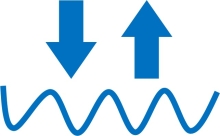

Understanding tides
Knowing what tides are doing is very useful when visiting a beach and can keep you safe.
What is low tide and high tide
(click on it for a bigger version)
Neap Tides and Spring tides
Twice a month we have small neap and twice we have larger spring tides. Here's why:
What is a rip current?
What is a rip tide?
A rip tide is a strong current that goes away from the shore. They can be strong enough to pulla swimmer or surfer away from shallow water and into deeper water. Once in a rip, it can be difficult to get out and swim against the strong current.
How to spot a rip
The best way is to check the beach beforehand. Do some research? Are rip tides common on the beach? Talk to the lifeguards and ask them if there is a rip current present in any part of the beach or bay.
Alternatively, a rip may be given away by:
- A patch or channel of water which is different from the water artound - smoother, or choppier or darker.
- A patch or channel carrying more debris than the water around
- A break in the waveline
The higher up you are, the clearer these types of patterns indicating a rip may be. Standing on higher ground looking down on the beach can help.
Swim between the swimming flags
on a lifeguarded beach
If you find yourself caught in a rip
If you feel you are being pulled away from the shore in a rip -
- if you are not out of your depth, try to wade rather than swim
- if you are in deep water, swim parallel to the shore until you are out of the rip, then swim and wade to the shore
- if you have a board, keep hold of it and phone 999 and ask for the coastguard
- if you are a swimmer in difficulty, float on your back and raise a hand and shout for help.
If you see someone in difficulty in a rip,
dial 999 and ask for the Coastguard.
CHECK THE TIDES
Always check the tide times before you go beach - to make sure you are not going to get trapped by high tides.

You can check the tides online - it will tell you both the times of high tides and the expected height of the tides:






